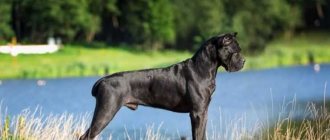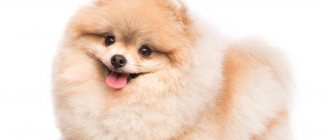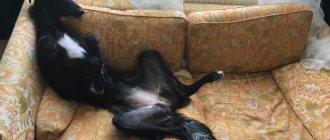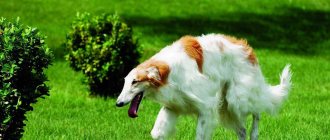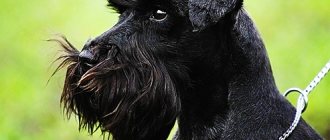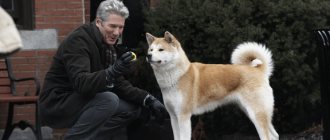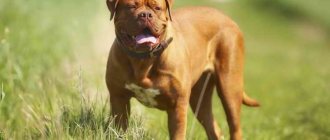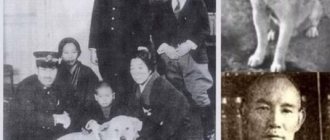Features of breeds
Shiba Inu
Dogs of this breed are unpretentious in food and do not require special living conditions. They are quite flexible and always act differently depending on the conditions. They are distinguished by quick reactions and a well-developed instinct of self-preservation.
Quite curious. This is due to the fact that they always need to explore the people and animals around them in order to feel safe.
However, they are friendly and friendly.
They have high intelligence and are able to feel a wide range of emotions.
Distinctive appearance features:
- wide head with a pointed tip, reminiscent of a fox;
- dark almond-shaped eyes;
- thick and powerful neck with withers;
- the same wide and strong back;
- the maximum height of individuals reaches 42 cm;
- small, triangular-shaped ears slanting down;
- maximum weight – 14 kg, average weight – 10 kg.
Akita Inu
Puppies are considered to be individuals under two years of age. This is exactly the breed of dog that requires special attention, full education and training from birth - only with all this will the pet grow up as a faithful companion.
Adults behave quietly, reservedly, sometimes a certain caution can be traced in their behavior, but upon closer acquaintance with the dog, its friendly character immediately becomes apparent.
Since childhood, these dogs have been distinguished by restlessness and playfulness - they rarely enter a state of aggression. The exception is situations when their owner is in obvious danger.
Dogs can be independent in making their own decisions. A representative of this particular breed starred in the famous film “Hachiko: The Most Faithful Friend.”
The dog's appearance can be described by the following features:
- large head, similar to a blunt triangle;
- small upturned ears;
- a rather wide skull, the bone between the ears is flat, forming a hollow between the eyes;
- the neck muscles are well developed, the neck itself is short and thick;
- wide chest;
- the average length of the coat is 5 cm, the hairs on the tail are longer;
- The height of a male can reach 71 cm, and a female – 61 cm, while the average weight of representatives is about 35 kg.
Akita Inu. Description of the breed
Exterior
The height of Akita males is from 64 cm to 70 cm; The height of female Akita breeds is from 58 cm to 64 cm.- The weight of Akita males is from 30 to 40 kg; female Akita breed - from 20 to 30 kg.
- The life span of an Akita Inu is from 9 to 13 years.
- The tail is quite thick and wrapped in a donut.
- The Akita Inu has a very hard, double coat - this is explained by the harsh climate in which dogs of this breed lived.
Color options
Acceptable colors:
- pale yellow
- white
- brindle
- red-red
Japanese breeders strived for a simple and at the same time majestic appearance of dogs.
Characteristic of Akita dogs is an almost square body format - the height and length of the body are related as 10 to 11.
In general, a harmonious build, a muscular body and energetic movements - this is the standard for the Akita breed.
Character
The most important character trait of a dog of this breed is its tendency to dominate!
Even a puppy that has just arrived in the house will demonstrate its independence and independence, as well as its opinion. Somewhat softer and more flexible in the character of the bitch. For families with small children, it is recommended to adopt female dogs.
Their maternal instinct and proper training. perhaps they will make living together an Akita Inu and children safer and more joyful. The peculiarity of the dog is an innate sense of confidence and high intelligence.
Not every owner can cope with raising an Akita Inu. To establish contact with a dog you need to show a lot of endurance and patience. .
Comparison of characters
These two wonderful dog breeds are so similar to each other that professional breeders have developed several criteria by which they can be distinguished.
The main ones are differences in temperament.
- Disciplinary factor. The Akita Inu needs it less than the Shiba Inu. The former become attached to the owner due to their receptivity and affectionate nature. For the latter, discipline can become an essential part of affection.
- Behavior in a conflict situation. When this occurs (this is a fairly common occurrence for dogs), the Shiba Inu is limited to growling and a threatening position. The likelihood that an Akita Inu will rush into a fight is quite high.
- Dominance. There are more dominant individuals among the Akita Inu breed than among the Shiba Inu. The latter are more willing to make concessions and compromises.
- Relationships with children. Since the Akita Inu always tries to dominate, a representative of this breed will try to do this in relationships with children. These dogs may not get along well with children under 8 years of age. A dog's behavior can only be corrected through persistent training. In addition, they can be vindictive towards children - they can remember a careless kick or bite of a child. Later they will certainly show aggression towards the baby. A Shiba Inu can become a good “nanny” and a child’s faithful friend. Such dogs always try to adapt to the character and habits of their household members. But they also need to be trained, thereby taming them to frequent displays of affection and physical contact.
- Attachment criterion. The Akita Inu breed is more attached to the owner than the Shiba Inu, and at the same time depends on him. The attitude of the Shiba Inu is more like affection and maintaining a comfortable “constancy” in relation to the owner.
- House maintenance. The Akita Inu is a calmer and more docile dog if well trained. She can live in an enclosure or in a designated corner with a pillow. The Shiba Inu can be a "hooligan" and is prone to running away. Such a dog does not tolerate life on a chain and becomes aggressive. She needs daily exercise, otherwise she will chew all the furniture in the house. You can keep it on a chain or in an enclosure only with sufficient communication with the owner and physical fatigue.
- Habits. The Akita Inu has a strong hunting instinct. For this reason (if this fact is not compensated for by training), the dog may become more aggressive. The Shiba Inu has more of the habits of a companion. She is less aggressive, and she needs training more to maintain discipline, as mentioned above. Due to its relatively flexible and playful character, it takes part in various competitions and exhibitions.
- Endurance criterion. Professional breeders have noticed that the Shiba Inu dog breed is hardier than the Akita Inu.
- Relationships with other pets. The Shiba Inu does not get along well with cats, birds and rodents. Akita Inu is much more democratic towards other pets.
Differences in Appearance
Most often, both breeds are described almost identically, but this is not entirely correct. Professional breeders and some amateur dog breeders are able to immediately distinguish these two breeds from each other.
The very first difference that catches your eye is the difference in size between the representatives of these two breeds.
The Akita Inu is taller and larger than the Shiba Inu.
This should be taken into account by those who choose which of the two breeds to get. If the Shiba Inu can live in a small room, then the Akita Inu will feel more comfortable in a private house with a large territory. This is due to the fact that a larger dog requires a larger habitat.
Wool cover. The Akita Inu breed has a thick coat and an additional fluffy coat. The Shiba Inu's coat is not that thick.
If for the first breed it is necessary to comb only once a week, then for the second this should be done almost daily and with the help of a special comb, which has a slicker in its design.
There are noticeable differences between the two breeds in color.
Akita Inu can be white, red with white spots on the chest and paws, or white and red with a brindle tint, and Shiba Inu can be red, sesame, sesame and even black.
Who is better to choose?
For families with children, as mentioned above, it is best to choose the Shiba Inu breed.
Akita Inu can be a good companion for active people who love daily work.
Their tenacity goes well with the need for daily training of this breed.
At least once a week you should let your dog walk without a collar. Regular walks should be taken in the morning and evening, lasting 1 hour.
If the owner is a cat person, but still decides to buy a dog, then it is better to choose the Shiba Inu breed.
Breeds similar to Akita Inu
You won’t find a complete copy of Akita, if the issue is price, look for PET class puppies, their cost is much less compared to purebred dogs. Among the outwardly similar dogs, two breeds can be easily distinguished: Shiba Inu and American Akita. All three breeds have common roots, so in appearance they are also not much different.
American Akita
All Japanese dogs were under threat of destruction during the Second World War. Only German shepherds were abandoned, but Japanese dog breeders managed to preserve all 14 indigenous breeds. At the end of hostilities, American soldiers transported several dozen Akita Inu puppies to the United States and Canada. Local breeders began crossing Japanese beauties with mastiffs and German shepherds.
Such selection methods led to the enlargement of the Akita Inu, as a result of which several characteristic differences appeared. Dogs bred in the USA have a larger build, while the original Akita has a more refined build. Such differences led to the recognition by the American Kennel Club of a separate breed - the American Akita.
Today both breeds are equally popular. The cost of dogs similar to Akita Inu from America only starts from 25,000 rubles, while the indigenous dogs of Japan start from 35,000 rubles. You can compare both breeds using photographs.
Shiba Inu
These breeds have common roots, but different destinies. In Japan, the Akita was the favorite dog of emperors and courtiers, and the Shiba lived primarily in monasteries and villages. Despite this, the breeds simultaneously gained worldwide recognition - in 1064 a standard was adopted for both breeds.
The breeds are very similar in appearance, especially in photographs. However, when viewed in person, a huge difference in size is striking.
Akita and Shiba are very similar in appearance, but the first is almost 2 times larger. Akita's height reaches 70 centimeters, Shiba's is only 42 centimeters.
At the same time, Shiba Inu is considered a small copy of Akita. This breed is chosen for keeping in a small city apartment. The price for a similar breed, only smaller, starts at 20,000 rubles.
Origin of the Akita Inu dog breed
Akita Inu is the largest Japanese dog breed. The name translates as “dog from the Akita province.” In appearance it is similar to a Shiba Inu or a “Japanese dwarf”, they differ only in size. These are dogs from the Spitz group, descended from the ancient matagi ken, which were used in ancient times to hunt large animals, even bears. The ancestors of modern Akitas lived on the islands of Japan 8 thousand years ago. Archaeologists have found many images of such dogs in ancient tombs. Ancient hunting dogs were strong, hardy, and could withstand harsh climatic conditions. Of these, people began to select those who were more attached to home and person.
Selection was carried out in the province of Akita. These calmer and more loyal dogs began to be used as guard dogs. The emperor liked the new breed and became popular among the nobility. The first documents describing such dogs date back to the 17th century. Their peculiarity is that no other breeds were used during selection, so they retained all the characteristics of ancient dogs.
Akita Inus are valued in Japan, it was forbidden to offend them, even to raise your voice. In the imperial palace, every dog had a servant. They were considered sacred, and in the 20th century they were declared “natural monuments” and “treasures of Japan.”
In the 19th century, they tried to cross native Japanese breeds with dogs brought from Europe, trying to improve them and increase their size in order to use them in dog fighting. Because of this, they began to lose their breed characteristics and became aggressive.
At the beginning of the 20th century, a society was created to preserve native Japanese breeds. The most famous of them are the Akita and Shiba Inu. They were prohibited from crossing with other breeds. In the 30s, the first standard was created, the breed was registered under the name Akita Inu. Another test awaited these dogs during World War II. They took part in battles and were almost exterminated. Some representatives of this breed were preserved thanks to fanciers who hid them in remote villages. And after the war its revival began. At the same time, a second breed line appeared - the American Akita Inu. These dogs were bred from individuals brought to America by the military. This is how the ancient Japanese breed spread throughout the world. Interesting historical photos and pictures:
Historical photo of Akita Inu dog
Historical photo of Akita Inu dog
Historical photo of Akita Inu dog
Features of the mini Akita Inu dog breed, their appearance, maintenance and care
Many people would like to have an Akita Inu pet, but their living conditions do not allow them to keep a dog of such a large size. However, there is a way out: after all, there is a breed of dog in the world that looks almost the same as the Akita Inu, but is about half its size.
This mini version of the Akita is suitable for apartment living and is easier to feed and train. However, she has some breed characteristics that need to be taken into account by those who are planning to purchase her.
The history of the Akita Inu dog breed
This dog breed gained popularity after the release of the famous film “Hachiko”. Hachiko was a representative of the Akita Inu breed.
This breed appeared in the Middle Kingdom.
One of the northern provinces of the Japanese islands was called Akita?? and the dog breed was named in a similar way. According to some historical estimates, the Akita dog breed is approximately 8 thousand years old.
The ancestors of modern Akita were called Matagi Inu; these dogs guarded the yard and hunted large game. However, they themselves were quite small in size.
Around the 17th century, the current name of the dog breed was established - Akita Inu and the breed changed its specialization - the Japanese nobility chose them as their bodyguards.
After some time, keeping such a dog became fashionable; servants were assigned to the dogs and their life processes were filled with rituals.
Obviously, it was then that such a pronounced sense of self-esteem and rejection of violence and shouting took root in the character of the Akita dog.
With the advent of fashion for dog fighting, Akita Inu dogs began to be used in this form - as fighters. To make the breed larger and stronger, Akita dogs were bred with mastiffs.
In 1927, the Japanese decided that the breed needed to be restored to its original appearance. Akita Inu dogs have become a symbol of one of the cities in Japan.
Before the Great Patriotic War, the number of dogs was increased, and the breed acquired its original appearance. During the war, brave and loyal Akita Inus participated in the fighting just like their owners.
Almost all of them died; only those representatives of the breed survived which the owners managed to hide from the authorities.
After the war, the Americans took several dogs of this breed to America and there, as a result of crossing with Molossians, the American Akita breed appeared.
Appearance, standard and photo
The Shiba is a relatively small dog with a proportional, harmonious and moderately muscular build . The ratio between height at the withers and body length is 100:110 in males; in females the body format is somewhat more elongated.
The head is of a size commensurate with the body, with a wide skull, a clearly defined transition to a muzzle slightly tapering towards the end. The cheekbones are well defined, and there is a small longitudinal groove on the forehead. The eyes are slightly slanted, small, triangular in shape, their color is one of the shades of dark brown.
The ears are erect, medium-sized, triangular, turned forward. The nose is black. The neck is strong and quite muscular. The back is strong and straight. The stomach is tucked, but not excessively. The tail is set high, curled into a ring on the back.
The limbs are smooth and parallel, moderately muscular and quite strong . The paws are arched, tightly compressed, with elastic and durable pads and dark claws. The coat is very dense and thick, the so-called “wild” type: it consists of a straight and fairly rigid spine and a soft, dense undercoat.
Desirable colors: red, sesame, red sesame, red sesame, black and tan. Sand and white are acceptable, but not desirable.
For any color, “urazhiro” is required - lightening of the fur on the sides of the muzzle, cheekbones, neck, chest, belly, limbs and lower part of the tail.
Next you will see how representatives of this breed look in the photo:
Description of the breed
Akita Inu is often called the Japanese husky, but such a name has the right to exist only as an association. Our heroes have nothing in common with the husky. Existing standards give us the following description:
- This is a very proportional dog, all parts of the body are related to each other in ideal proportions .
- The head is small, wedge-shaped, tightly covered with skin, without folds or sagging.
- Visually, the nose resembles a rectangle. The tip is pigmented in black, pink or brown, depending on the color of the coat. Black is always preferable.
- The teeth have the correct bite.
- The eyes are slightly elongated, oval, with raised corners. The iris is always dark in color.
- The body is strong, powerful, slightly elongated.
- The limbs are dry, muscular, smooth.
- The tail is set high, curled into a ring and laid over the back. It is possible that this is one of those similarities with the husky, which was the reason to give the dog a second unofficial name.
- Height at the withers can reach seventy centimeters.
- The average weight is forty-five kilograms.
The wool cut has three layers. The guard hair is not long and quite hard. The second layer is less rigid and even shorter. There is a thick undercoat, which is considered the third layer. There are four common colors: brindle, sesame, red and black.
